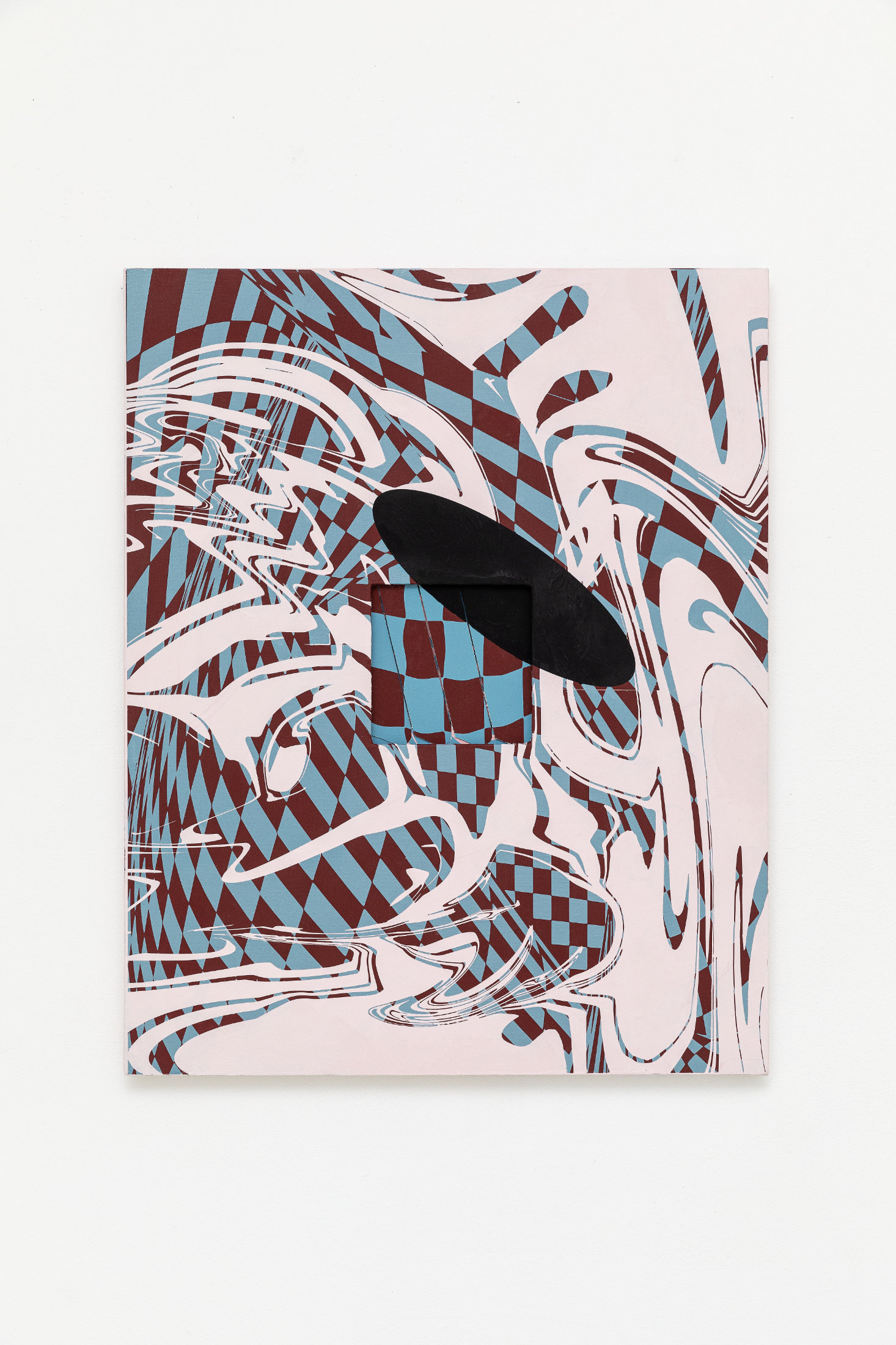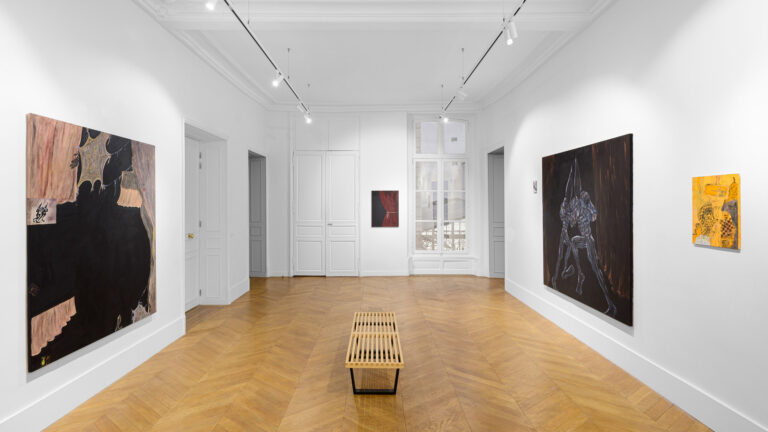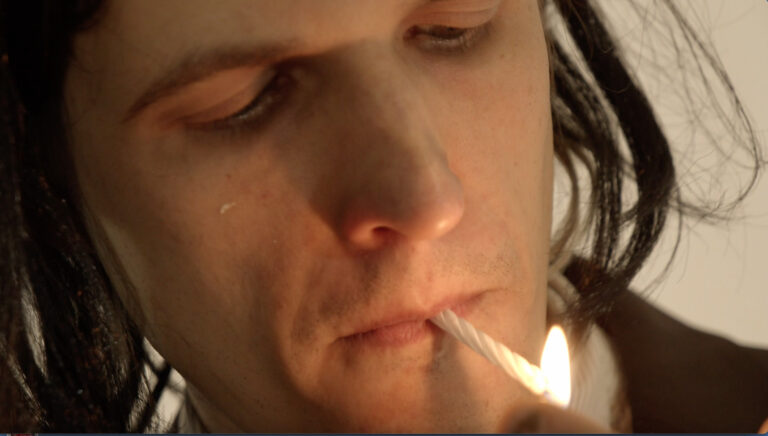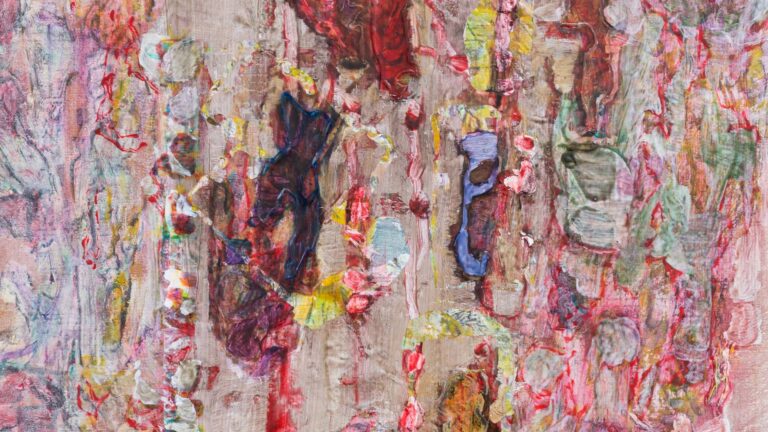Artists: Kevin Desbouis, Pati Hill, Charlotte Houette
Exhibition title: other people’s clothing
Curated by: Fiona Vilmer
Venue: Les Bains-Douches, Alençon, France
Date: March 11 – April 24, 2022
Photography: Romain Darnaud / all images copyright and courtesy of the artists and Les Bains-Douches, Alençon
“Tonight, my aunt’s half-moods arrive in the room. They mirror the room and its furniture like a TV screen. They look like other people’s clothing.” 1
Tan Lin’s Insomnia and the Aunt is, in his words, an ambient novel. The narrator describes time spent with his insomniac aunt who runs a motel in the middle of the United States. She spends her sleepless nights watching the TV set, and prefers rerun programmes to live TV. For her, as a Chinese immigrant, America is neither an image nor the television itself but the furniture in which the screen is mounted that reflects the illusion of her Americanization.
From the anonymous corridors of the motel, where passages are fleeting/elusive, the TV set covers the aunt’s reality, it is an object, a mirror, a character. I picture her zapping continuously, watching snippets of programmes, late-shows, movies, documentaries. While staying awake, her mind would wander until the viewing loop sketches out a fiction of herself, with the intuition that something is always happening somewhere (else). A somnolent delirium where it would be possible to disappear into a mental scape upon which to rewrite the world. The TV set is a backgroundless box ornamented as an altar, a machine to incarnate. When the aunt disappears, an ambiguity prevails : has she been absorbed by the TV set or was she a pure emanation of the TV set ?
The aim here is not so much to find an answer but rather to prefer the generality of the question, until the aunt is no more than a character, and the TV set, a domestic object.
other people’s clothing brings together Kevin Desbouis, Pati Hill and Charlotte Houette. On the outside, the forms chosen for their pattern, their value or their literalness that crowd the exhibition space look like they do not belong where they do. Yet in the liminal realm of the ready-made they do, and they appear – among other things – as a prop to be activated, a partition of the space or an image. These objects that accompany us carry with them a dissolution of context and their initial meaning, drawing us closer to a kind of fiction or editing2 of the self. The term is a wink at the reverse side of the exhibited artistic practices tied to text, publication and translation. We disappear into a painting as we slip under a mask. Concealed in a dressing/ voting booth, we extract ourselves and the shapes flatten out under the light.
Kevin Desbouis proposes installations, using a range of forms mainly constituted by ready-mades, in which intensity or its absence is a fundamental parameter. He consideres the labour of art as a set of moments, of situations that are not explicit or with a partially accomplished potential, which may contain cinematic, erotic or suppressed aspects. Kevin Desbouis’ works thus produce a combination of dissatisfaction and fascination, and approach what Sianne Ngai has theorised as a judgement: the gimmick, which can be “a trick, a wonder and sometimes just a thing.”3 The distance between the object and the subject courts a possible confusion, between disappointment and seduction. Accordingly, the works that he develops using voting booths, in an analogy between the polling booth, the fitting room or the confessional, open up situations where one can manipulate or dress up with props, which generally does not happen without mutual embarrassment. Sometimes it even seems that both the work and the audience do not fully belong together. As if they were following a hidden script, Kevin Desbouis’ works involve modes of production in which various intermediaries and their individual interventions strongly influence the final result of the work.
In the early 1970s, after a thirteen-year break from publishing, Pati Hill began photocopying her domestic environment. Objects, clothes and food are recorded on a real scale by the copier, who renders them a distanciation without any nostalgic consideration. Pati Hill’s xerography evacuates fascination in favour of profusion, and reveals her critical attention to the circumscribed objects around her, to their presence4, to her condition as a housewife and to what happens outside this condition. The bureaucratic device assigned to secretarial work, here emancipating from this context, is used in Pati Hill’s work in a literal, compulsive way. On a black toner background – which she sometimes injects in excess – the instantaneous duplication accentuates details and edges. The forms no longer stick to their initial condition of existence, but float, suspended inside the page. This work on the copier does not so much reveal what is invisible to the eye, but imprints the strange and familiar reverse face of objects. The image returns their fiction, the machine their uncertainty. The machine and the objects are the tools for the invocation of a visual language.
Charlotte Houette’s paintings create fantasmatic spaces. Elements are incorporated into her paintings like mock-ups, projecting a space that is both architectural and mental. These wanderings have sparkling effects. Between abstraction and the ready-made, these spaces are always empty and yet haunted. They evoke the constructions close to the prototype of the Winchester Villa in California5. A trap-ghost house where it is said that at night the owner, Ms Winchester, relies on the spirits that dictate to her the architecture of impossible rooms5. Charlotte Houette’s paintings reproduce the mechanisms of appearance and disappearance of books with pop-up images. Her works create spatial loops that distort the regimes of visibility where patterns repeat and stretch, colouring a psychedelic movement. Charlotte Houette’s works have a swirling atmosphere with a saturated effect as if never quite awake, a sensation of derealization awaits, affecting us as much as the visual effects they produce.
other people’s clothing addresses a question of attitude viewed through forms and their frontality. If these forms can be seen as illusory depths, they should be seen as surfaces on which fictions of self fade, and re-cast the roles. Also edited, these forms suggest changes of state – some more dramatic or comic – and altered processes of visibility. A replacement in reality that fosters a critical reflection on the existence and presence of objects, in which a certain intensity seems to have been injected, more erotic or enigmatic. Drilling imaginary holes, directly into their reversibility. These associations of the mind lead us to a “delirium of digression “6 generated by these visual distortions, which arouse phenomena of absorption, so that presences are created, confused, amazed or ghostly.
After all, the motel in the beginning hosts a character who doesn’t seem to exist anywhere. One could also realize that it was no more than a fever dream, as if one had fallen asleep in front of the TV set.
Fiona Vilmer, March 2022
1. Tan Lin, Insomnia and the Aunt, Chicago, Kenning Editions, 2011.
2. Treatment of a text or a film consisting of modifying, deleting, keeping or adding elements preceding the finished piece.
3. Sianne Ngai, Theory of the Gimmick. Aesthetic Judgement and Capitalist Form, Harvard University Press, 2020.
In her book Sianne Ngai theorizes the gimmick as an aesthetic judgment and a virtual form in capitalism. The gimmick is “irritating yet strangely attractive”, it is “linked to our perception of an object making untrustworthy claims about the saving of time, the réduction of labour and the expansion of value.”
4. Text by Baptiste Pinteaux on the occasion of the exhibition Heaven’s door is open to us / Like a big vacuum cleaner / O help / O clouds of dust / O choir of hairpins, September 12 – October 17, 2020, Galerie Air de Paris, Romainville.
“True, they (the works) may signify one of those “little luxuries that went with being a prisoner“: that of a more finely honed attentiveness to things and their presence, but this attentiveness is not so much sensitive as critical.”
5. From 1884 to 1922 Sarah Winchester is believed to have stayed alone with the workers who carried out the construction of her house. Articles suggest that its maze-like construction is designed to mislead spirits. But there is no evidence that the owner believed it to be haunted. The house is populated by fictitious windows and staircases and doors to rooms that have disappeared.
6. Julie Becker, Bernhard Burgi, eds. Julie Becker: Researchers, Residents, A Place to Rest. Zurich: Kunsthalle Zurich, 1997. p33.
“delirium of digression”. I borrow this expression from the American artist Julie Becker which she uses to describe her artistic work consisting of installations, photographs, videos, drawings and collages.
Special thanks to Sophie Vinet, Kevin Desbouis, Charlotte Houette, and to Baptiste Pinteaux, Nicole Huard, and Florence Bonnefous (Galerie Air de Paris) for the presence of Pati Hill in this exhibition.
other people’s clothing, 2022, exhibition view, Les Bains-Douches, Alençon
other people’s clothing, 2022, exhibition view, Les Bains-Douches, Alençon
other people’s clothing, 2022, exhibition view, Les Bains-Douches, Alençon
other people’s clothing, 2022, exhibition view, Les Bains-Douches, Alençon
other people’s clothing, 2022, exhibition view, Les Bains-Douches, Alençon
other people’s clothing, 2022, exhibition view, Les Bains-Douches, Alençon
Kevin Desbouis, Casting, 2022, wood, thread, statuettes, variable number of elements, variable dimensions
Kevin Desbouis, Casting, 2022, wood, thread, statuettes, variable number of elements, variable dimensions
Charlotte Houette, Untitled (Green), 2022, acrylic on canvas, 60,5 x 75 cm
Pati Hill, Untitled, c.1980, cut-out photocopy color. Courtesy Air de Paris, Romainville
Kevin Desbouis, Untitled (Moist), 2022, voting booth, finger moisteners, cotton, 200 x 80 x 80 cm
Kevin Desbouis, Untitled (Moist), 2022, voting booth, finger moisteners, cotton, 200 x 80 x 80 cm
Pati Hill, Untitled (telephone), c.1977-79, serie (Common Objects), photocopy, 28 x 21,5 cm. Courtesy Air de Paris, Romainville
Kevin Desbouis, Untitled (Cake), 2022, mixed media, 50 x 35 cm
Charlotte Houette, Untitled (Purple psyche), 2022, acrylic on canvas, 60,5 x 75 cm
Pati Hill, Untitled (pear), c.1976, photocopy on green paper, 23 x 21,7 cm. Courtesy Air de Paris, Romainville
Charlotte Houette, Untitled (Green), 2022, acrylic on canvas, 56 x 70 cm
Charlotte Houette, Untitled (Pink), 2022, acrylic on canvas, 60,5 x 75 cm
Charlotte Houette, Untitled (Yellow), 2022, acrylic on canvas, 60,5 x 75 cm
Charlotte Houette, Untitled (Heart), 2022, acrylic on canvas, 60,5 x 75 cm
Pati Hill, Untitled, c.1980, serie (A Frolicking), photocopy, 21 x 29,7 cm (each). Courtesy Air de Paris, Romainville
Pati Hill, Untitled, c.1980, serie (A Frolicking), photocopy, 21 x 29,7 cm (each). Courtesy Air de Paris, Romainville
Kevin Desbouis, Untitled (Blue Night), 2022, voting booth, mask, mirror, cotton, variable elements, 200 x 80 x 80 cm
Kevin Desbouis, Untitled (Blue Night), 2022, voting booth, mask, mirror, cotton, variable elements, 200 x 80 x 80 cm






























